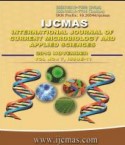


 National Academy of Agricultural Sciences (NAAS)
National Academy of Agricultural Sciences (NAAS)

|
PRINT ISSN : 2319-7692
Online ISSN : 2319-7706 Issues : 12 per year Publisher : Excellent Publishers Email : editorijcmas@gmail.com / submit@ijcmas.com Editor-in-chief: Dr.M.Prakash Index Copernicus ICV 2018: 95.39 NAAS RATING 2020: 5.38 |
Pseudomonas fluorescens culture was applied at different dilutions to induce resistance in Tomato (Solanum esculentum L.) against the root-knot nematode, Meloidogyne incognita. The efficacy of this culture, when applied as a soil drench or root dip, was compared with inoculated non-treated plants under greenhouse conditions. P. fluorescens was able to reduce nematode parameters at all dilutions and in both types of application. The dilution 9x108cfu/ml was the most effective in reducing nematode reproduction as measured by the number of developmental stages, Plant height (cm), Root length (cm), Fresh and dry weight of Shoot and Root (gm), No. of galls/plant, and No. of egg masses/gall nematode reduction was 28.68 cm, 21.83 cm, 8.90gm, 2.12gm, 4.76gm, 0.89gm, 28.75 and 38.50 respectively) when treated as a soil drench compared to the untreated control inoculated with M. incognita only. This was followed by P. fluorescens at a concentration of 6 g/kg soil which significantly reduced the same parameters by 40.30cm, 27.15cm, 35.49gm, 7.18gm, 0.85gm, 0.26gm, 17.00 and 47.75, respectively compared to control inoculated with M. incognita only. Also, plant growth criteria improved in treated plots compared to controls. The activity of three enzymes (peroxidase, polyphenol oxidase and chitinase) increased in treated plants exposed to 9x108cfu/ml as bare root dip treatment and 6 g/kg soil as soil drenching compared to the inoculated untreated control. P. fluorescens thus induced resistance in tomato against M. incognita.
 |
 |
 |
 |
 |